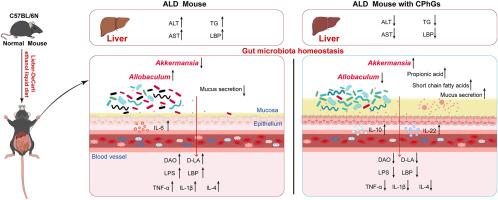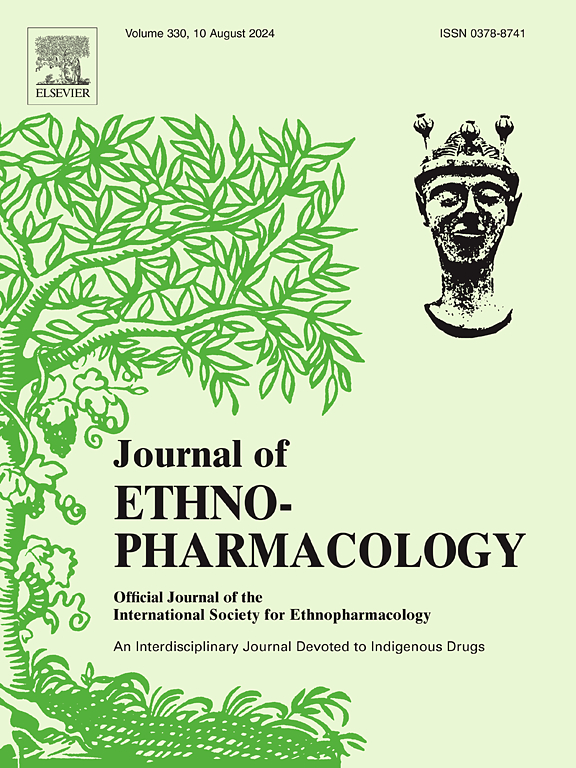肉苁蓉中的苯乙醇苷通过调节肠道微生物群平衡对急性缺氧性脑病的保护作用
IF 4.8
2区 医学
Q1 CHEMISTRY, MEDICINAL
引用次数: 0
摘要
民族药理学意义:肉苁蓉是一种具有新疆特色的中药材(茹苁蓉),在中国古代的许多医书中都有记载,常用作补药。在传统中医 "肝肾同源 "理论的支持下,菟丝子在补肾护肝方面有很多临床应用。现代药理研究也发现,管圆柏(C. tubulosa (Schenk) Wight)中的苯乙醇苷(CPhGs)在改善酒精性肝损伤方面具有重要的保护作用:研究目的:我们旨在研究 CPhGs 是否能通过靶向 "肠肝轴 "来提高酒精性肝病(ALD)的治疗效果,从而有助于了解中草药如何通过影响肠道微生物群来缓解疾病:利用Lieber-DeCarli酒精流质饮食建立了ALD小鼠模型,并在假绝育小鼠模型和粪便微生物群移植(FMT)小鼠模型中研究了中草药对ALD小鼠肠道屏障和肠道微生物群的影响。根据 NIAAA 模型,我们用 Lieber-DeCarli 乙醇流质饮食喂养雌性 C57BL/6N 小鼠。动物实验中,长期乙醇饮食干预6W,短期干预11d。同时还进行了 FMT 实验:结果:CPhGs 能明显改善 ALD 的表现。在长期 NIAAA 小鼠模型(L-Pair)中,与对照饮食组相比,ALD 小鼠表现出明显的肠道微生物群失调和 Allobaculum 的异常增殖。在接受长期干预的小鼠中,CPhGs 治疗组的肠道屏障功能得到改善,同时 Allobaculum 的丰度显著下降,Akkermansia 的丰度显著上升。此外,与小鼠灌胃来自长期NIAAA小鼠供体的粪便微生物群(FMT-EtOH)相比,小鼠灌胃来自长期NIAAA模型供体的高剂量(700毫克/千克)CphGs粪便微生物群(FMT-EtOH-H)中的鹅口疮细胞数量、Akkermansia丰度和肠道短链脂肪酸浓度均显著增加。网络分析和物种分布结果表明,Akkermansia 和 Allobaculum 是肠道微生物群中丰度最高的菌属,它们之间的相互作用与丙酸代谢有关:结果表明,CPhGs 通过调节肠道中 Akkermansia 和 Allobaculum 的丰度和组成、维持肠道粘液平衡和保护肠道屏障完整性,对 ALD 具有保护作用。本文章由计算机程序翻译,如有差异,请以英文原文为准。

Protective effects of phenylethanol glycosides from Cistanche tubulosa against ALD through modulating gut microbiota homeostasis
Ethnopharmacological relevance
Cistanche tubulosa (Schenk) Wight, a Chinese herbal medicine (Rou Cong Rong) with Xinjiang characteristics, was recorded in many medical books in ancient China and often used as a tonic medicine. Supported by the traditional Chinese medicine theory of “homology of liver and kidney,” C. tubulosa (Schenk) Wight has many clinical applications in tonifying the kidney and protecting the liver. Modern pharmacological studies have also found that the protective effects of phenylethanol glycosides from C. tubulosa (Schenk) Wight (CPhGs) play an important role in ameliorating alcoholic liver injury.
Aim of the study
We aimed to investigate whether CPhGs can enhance the therapeutic outcome of alcoholic liver disease (ALD) by targeting the “gut–liver axis,” thus contributing to the knowledge of how Chinese herbs alleviate disease by influencing the gut microbiota.
Materials and methods
An ALD mouse model was established using the Lieber–DeCarli alcohol liquid diet, and the effects of CPhGs on the intestinal barrier and gut microbiota of ALD mice were investigated in a pseudo-sterile mouse model and fecal microbiota transplantation (FMT) mouse model. We fed female C57BL/6N mice with Lieber-DeCarli ethanol liquid diet, according to the NIAAA model. Animal experiment of long-term, ethanol diet intervention for 6W, and short-term for 11d. The FMT experiments were also performed.
Results
CPhGs significantly improved ALD manifestations. ALD mice demonstrated significant gut microbiota dysbiosis and significantly abnormal proliferation of Allobaculum compared with the control diet group in long-term NIAAA mouse model (L-Pair). In mice that received the long-term intervention, the improvement in gut barrier function in the CPhGs-treated group was accompanied by a significant decrease in the abundance of Allobaculum and a significant increase in the abundance of Akkermansia. Furthermore, compared with the mouse were gavaged fecal microbiota from the long-term NIAAA mouse donors (FMT-EtOH), the number of goblet cells, abundance of Akkermansia, and the intestinal short-chain fatty acid concentrations were significantly increased in the mouse were gavaged fecal microbiota from high (700 mg/kg) doses of CPhGs orally in long-term NIAAA model donors (FMT-EtOH-H). Network analysis and species distribution results demonstrated that Akkermansia and Allobaculum were the genera with the highest abundances in the gut microbiota and that their interaction was related to propionic acid metabolism.
Conclusions
The results suggest that CPhGs exert a protective effect against ALD by modulating the abundance and composition of Akkermansia and Allobaculum in the intestine, maintaining the intestinal mucus balance, and safeguarding intestinal barrier integrity.
求助全文
通过发布文献求助,成功后即可免费获取论文全文。
去求助
来源期刊

Journal of ethnopharmacology
医学-全科医学与补充医学
CiteScore
10.30
自引率
5.60%
发文量
967
审稿时长
77 days
期刊介绍:
The Journal of Ethnopharmacology is dedicated to the exchange of information and understandings about people''s use of plants, fungi, animals, microorganisms and minerals and their biological and pharmacological effects based on the principles established through international conventions. Early people confronted with illness and disease, discovered a wealth of useful therapeutic agents in the plant and animal kingdoms. The empirical knowledge of these medicinal substances and their toxic potential was passed on by oral tradition and sometimes recorded in herbals and other texts on materia medica. Many valuable drugs of today (e.g., atropine, ephedrine, tubocurarine, digoxin, reserpine) came into use through the study of indigenous remedies. Chemists continue to use plant-derived drugs (e.g., morphine, taxol, physostigmine, quinidine, emetine) as prototypes in their attempts to develop more effective and less toxic medicinals.
 求助内容:
求助内容: 应助结果提醒方式:
应助结果提醒方式:


